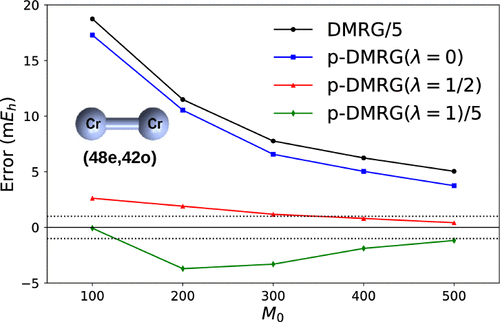当前位置:
X-MOL 学术
›
J. Chem. Theory Comput.
›
论文详情
Our official English website, www.x-mol.net, welcomes your
feedback! (Note: you will need to create a separate account there.)
A Perturbative Density Matrix Renormalization Group Algorithm for Large Active Spaces
Journal of Chemical Theory and Computation ( IF 5.7 ) Pub Date : 2018-06-21 00:00:00 , DOI: 10.1021/acs.jctc.8b00273 Sheng Guo 1 , Zhendong Li 1 , Garnet Kin-Lic Chan 1
Journal of Chemical Theory and Computation ( IF 5.7 ) Pub Date : 2018-06-21 00:00:00 , DOI: 10.1021/acs.jctc.8b00273 Sheng Guo 1 , Zhendong Li 1 , Garnet Kin-Lic Chan 1
Affiliation

|
We describe a low cost alternative to the standard variational DMRG (density matrix renormalization group) algorithm that is analogous to the combination of the selected configuration interaction plus perturbation theory (SCI+PT). We denote the resulting method p-DMRG (perturbative DMRG) to distinguish it from the standard variational DMRG. p-DMRG is expected to be useful for systems with very large active spaces, for which variational DMRG becomes too expensive. Similar to SCI+PT, in p-DMRG, a zeroth-order wave function is first obtained by a standard DMRG calculation but with a small bond dimension. Then, the residual correlation is recovered by a second-order perturbative treatment. We discuss the choice of partitioning for perturbation theory, which is crucial for its accuracy and robustness. To circumvent the problem of a large bond dimension in the first-order wave function, we use a sum of matrix product states to expand the first-order wave function, yielding substantial savings in computational cost and memory. We also propose extrapolation schemes to reduce the errors in the zeroth- and first-order wave functions. Numerical results for Cr2 with a (28e, 76o) active space and 1,3-butadiene with an (22e, 82o) active space reveal that p-DMRG provides ground state energies of a similar quality to variational DMRG with very large bond dimensions but at a significantly lower computational cost. This suggests that p-DMRG will be an efficient tool for benchmark studies in the future.
中文翻译:

大活动空间的摄动密度矩阵重整化群算法
我们描述了一种低成本的替代标准变体DMRG(密度矩阵重归一化组)算法的方法,该算法类似于所选配置交互和摄动理论(SCI + PT)的组合。我们表示所得的方法p-DMRG(微扰DMRG)将其与标准变体DMRG区别开来。预期p-DMRG对于具有很大活动空间的系统很有用,因为对于这些系统而言,变型DMRG太昂贵了。类似于SCI + PT,在p-DMRG中,首先通过标准DMRG计算获得零阶波函数,但键尺寸较小。然后,通过二阶微扰处理恢复残差相关。我们讨论了扰动理论的分区选择,这对于其准确性和鲁棒性至关重要。为了避免一阶波函数中键维数较大的问题,我们使用矩阵乘积状态的总和来扩展一阶波函数,从而在计算成本和内存方面节省了大量资金。我们还提出了外推方案,以减少零阶和一阶波函数中的误差。Cr的数值结果具有活动空间(28e,76o)的2和具有活动空间(22e,82o)的1,3-丁二烯的图2显示,p-DMRG提供了与变态DMRG相似质量的基态能量,具有非常大的键合尺寸,但是具有显着的键合尺寸。降低计算成本。这表明,p-DMRG将成为将来进行基准研究的有效工具。
更新日期:2018-06-21
中文翻译:

大活动空间的摄动密度矩阵重整化群算法
我们描述了一种低成本的替代标准变体DMRG(密度矩阵重归一化组)算法的方法,该算法类似于所选配置交互和摄动理论(SCI + PT)的组合。我们表示所得的方法p-DMRG(微扰DMRG)将其与标准变体DMRG区别开来。预期p-DMRG对于具有很大活动空间的系统很有用,因为对于这些系统而言,变型DMRG太昂贵了。类似于SCI + PT,在p-DMRG中,首先通过标准DMRG计算获得零阶波函数,但键尺寸较小。然后,通过二阶微扰处理恢复残差相关。我们讨论了扰动理论的分区选择,这对于其准确性和鲁棒性至关重要。为了避免一阶波函数中键维数较大的问题,我们使用矩阵乘积状态的总和来扩展一阶波函数,从而在计算成本和内存方面节省了大量资金。我们还提出了外推方案,以减少零阶和一阶波函数中的误差。Cr的数值结果具有活动空间(28e,76o)的2和具有活动空间(22e,82o)的1,3-丁二烯的图2显示,p-DMRG提供了与变态DMRG相似质量的基态能量,具有非常大的键合尺寸,但是具有显着的键合尺寸。降低计算成本。这表明,p-DMRG将成为将来进行基准研究的有效工具。











































 京公网安备 11010802027423号
京公网安备 11010802027423号